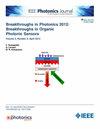Aspherical Surface Measurement With Multi-Directional Lateral Shearing Phase-Shifting Interferometry
IF 2.4
4区 工程技术
Q3 ENGINEERING, ELECTRICAL & ELECTRONIC
引用次数: 0
Abstract
Lateral shearing interferometry is an effective method for directly measuring the depth gradient of aspherical surfaces. To address the low phase reconstruction accuracy resulting from the fact that lateral shear interferometers typically obtain only two sets of wavefront data in a single orthogonal direction, which leads to fewer sampling points, this paper presents an aspherical surface measurement method based on birefringent crystals and multi-directional lateral shearing phase-shifting interferometry. This method overcomes nonlinear issues and environmental influences during phase-shifting interferometry, captures shear wavefront data in multiple directions, and reconstructs the surface by solving for the wavefront coefficients using multi-directional differential wavefront information. It also reduces system random errors, improving surface reconstruction accuracy. We propose a multi-directional lateral shearing synchronous phase-shifting interferometry technique for measuring aspherical surfaces. The methodology includes multi-directional shearing, synchronous phase-shifting, crystal birefringence modulation, phase grating diffraction, and polarization phase-shifting arrays. An experimental system was built to test aspherical surface samples, and aspherical surface measurements were conducted on a surface with a 90 mm diameter, 606 mm vertex curvature radius, and a quadratic conic coefficient of −1. The deviation of the measured aspherical surface from the optimal spherical surface was obtained, and the initial deviation of the ideal aspherical surface from the optimal spherical surface was calculated using the ray tracing method. The repeated measurement results were consistent with those from the ZYGO interferometer’s self-collimation method, with an RMS deviation better than λ/100. The experiment demonstrated the effectiveness, repeatability and measurement stability of the multi-directional lateral shearing interferometry system for measuring aspherical surfaces.多方向横向剪切移相干涉法测量非球面
横向剪切干涉法是一种直接测量非球面深度梯度的有效方法。针对横向剪切干涉仪通常只能在一个正交方向上获得两组波前数据,导致采样点较少,相位重建精度低的问题,提出了一种基于双折射晶体和多向横向剪切移相干涉的非球面测量方法。该方法克服了移相干涉测量中的非线性问题和环境影响,在多个方向上捕获剪切波前数据,并利用多向差分波前信息求解波前系数来重建表面。它还减少了系统随机误差,提高了表面重建精度。提出了一种测量非球面的多向横向剪切同步移相干涉技术。该方法包括多向剪切、同步移相、晶体双折射调制、相位光栅衍射和偏振移相阵列。建立了非球面样品测试实验系统,在直径为90 mm、顶点曲率半径为606 mm、二次锥系数为−1的曲面上进行非球面测量。得到了被测非球面与最优球面的偏差,并利用光线追迹法计算了理想非球面与最优球面的初始偏差。重复测量结果与ZYGO干涉仪自准直方法测量结果一致,均方根偏差优于λ/100。实验证明了该系统测量非球面的有效性、重复性和测量稳定性。
本文章由计算机程序翻译,如有差异,请以英文原文为准。
求助全文
约1分钟内获得全文
求助全文
来源期刊

IEEE Photonics Journal
ENGINEERING, ELECTRICAL & ELECTRONIC-OPTICS
CiteScore
4.50
自引率
8.30%
发文量
489
审稿时长
1.4 months
期刊介绍:
Breakthroughs in the generation of light and in its control and utilization have given rise to the field of Photonics, a rapidly expanding area of science and technology with major technological and economic impact. Photonics integrates quantum electronics and optics to accelerate progress in the generation of novel photon sources and in their utilization in emerging applications at the micro and nano scales spanning from the far-infrared/THz to the x-ray region of the electromagnetic spectrum. IEEE Photonics Journal is an online-only journal dedicated to the rapid disclosure of top-quality peer-reviewed research at the forefront of all areas of photonics. Contributions addressing issues ranging from fundamental understanding to emerging technologies and applications are within the scope of the Journal. The Journal includes topics in: Photon sources from far infrared to X-rays, Photonics materials and engineered photonic structures, Integrated optics and optoelectronic, Ultrafast, attosecond, high field and short wavelength photonics, Biophotonics, including DNA photonics, Nanophotonics, Magnetophotonics, Fundamentals of light propagation and interaction; nonlinear effects, Optical data storage, Fiber optics and optical communications devices, systems, and technologies, Micro Opto Electro Mechanical Systems (MOEMS), Microwave photonics, Optical Sensors.
 求助内容:
求助内容: 应助结果提醒方式:
应助结果提醒方式:


